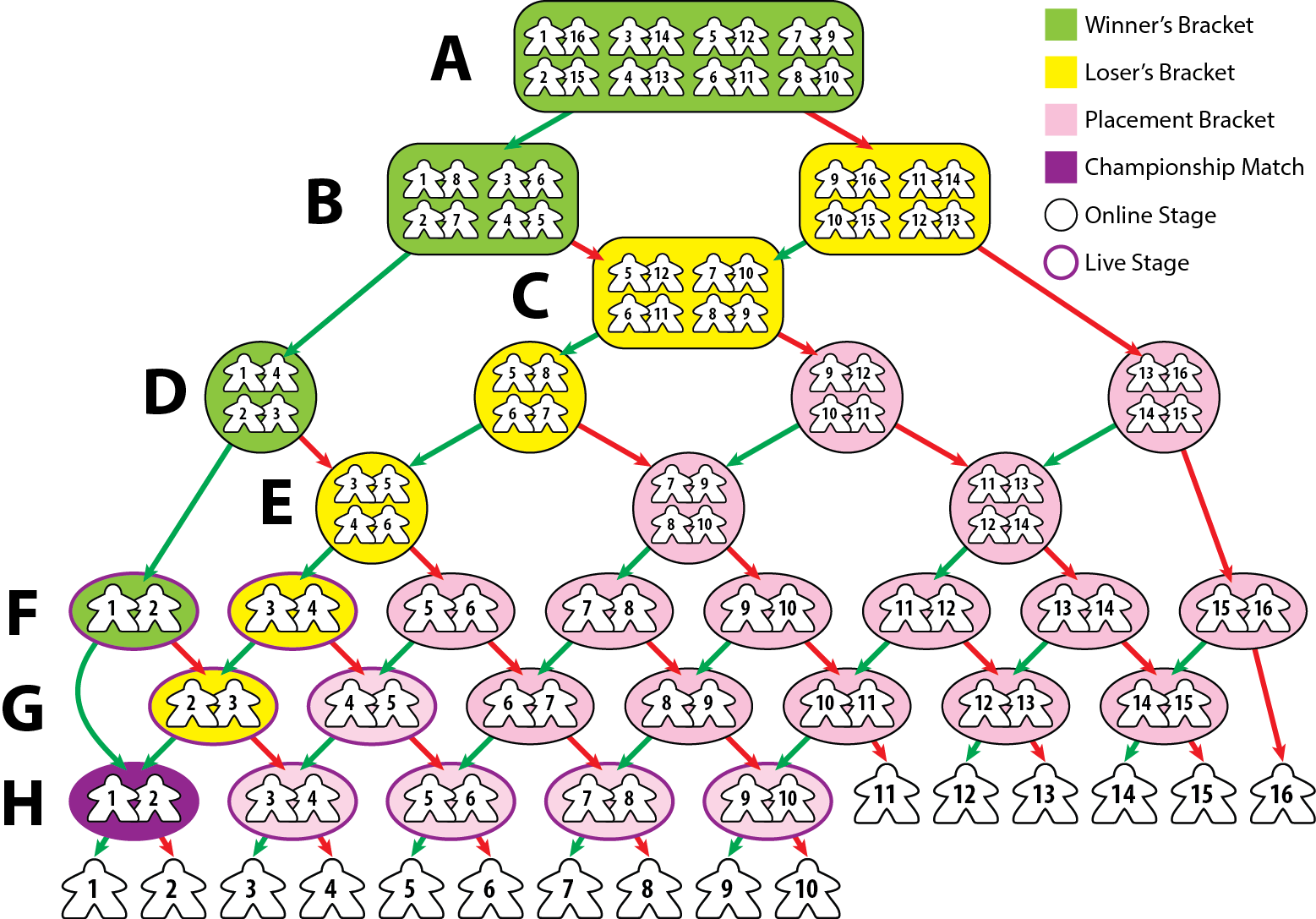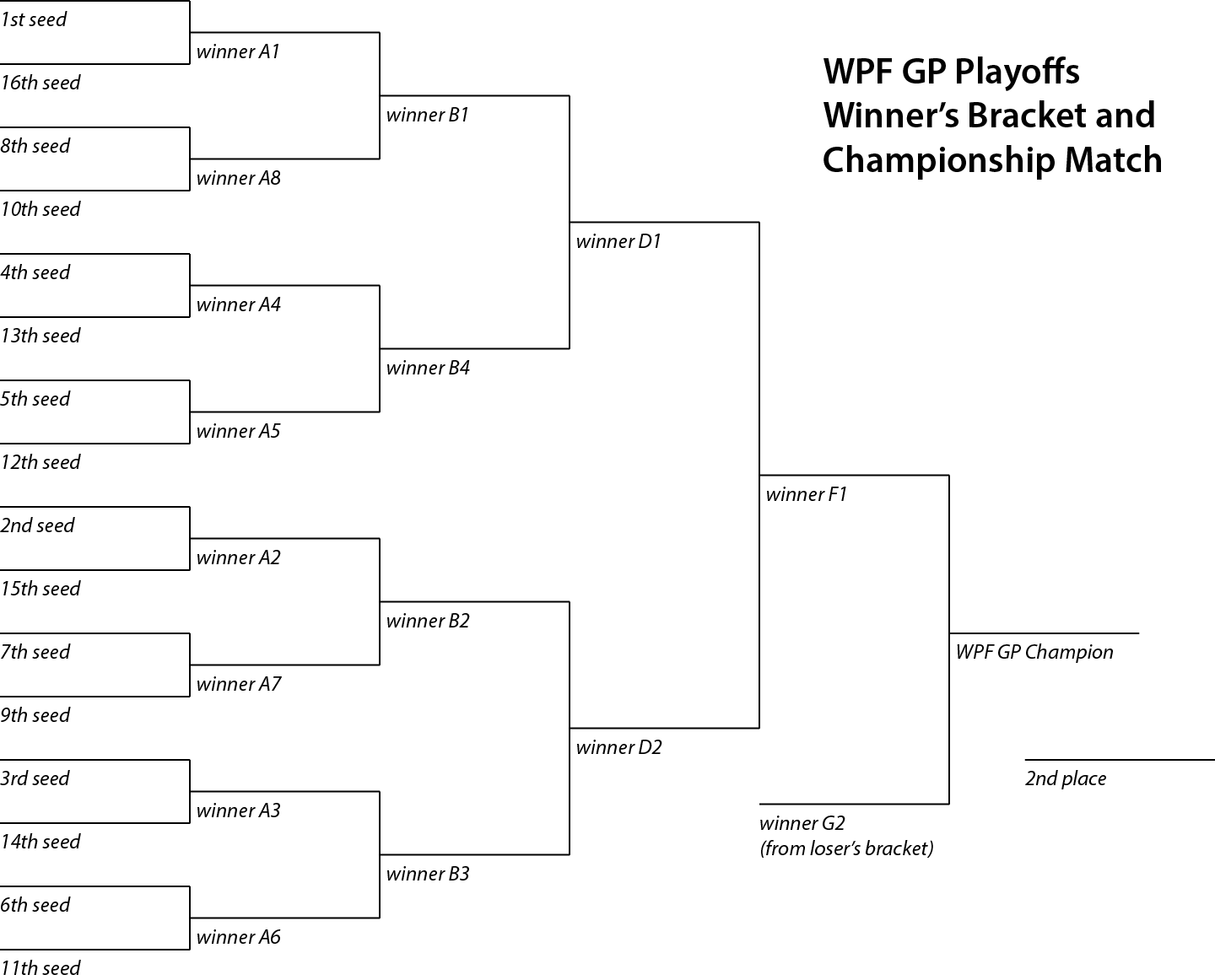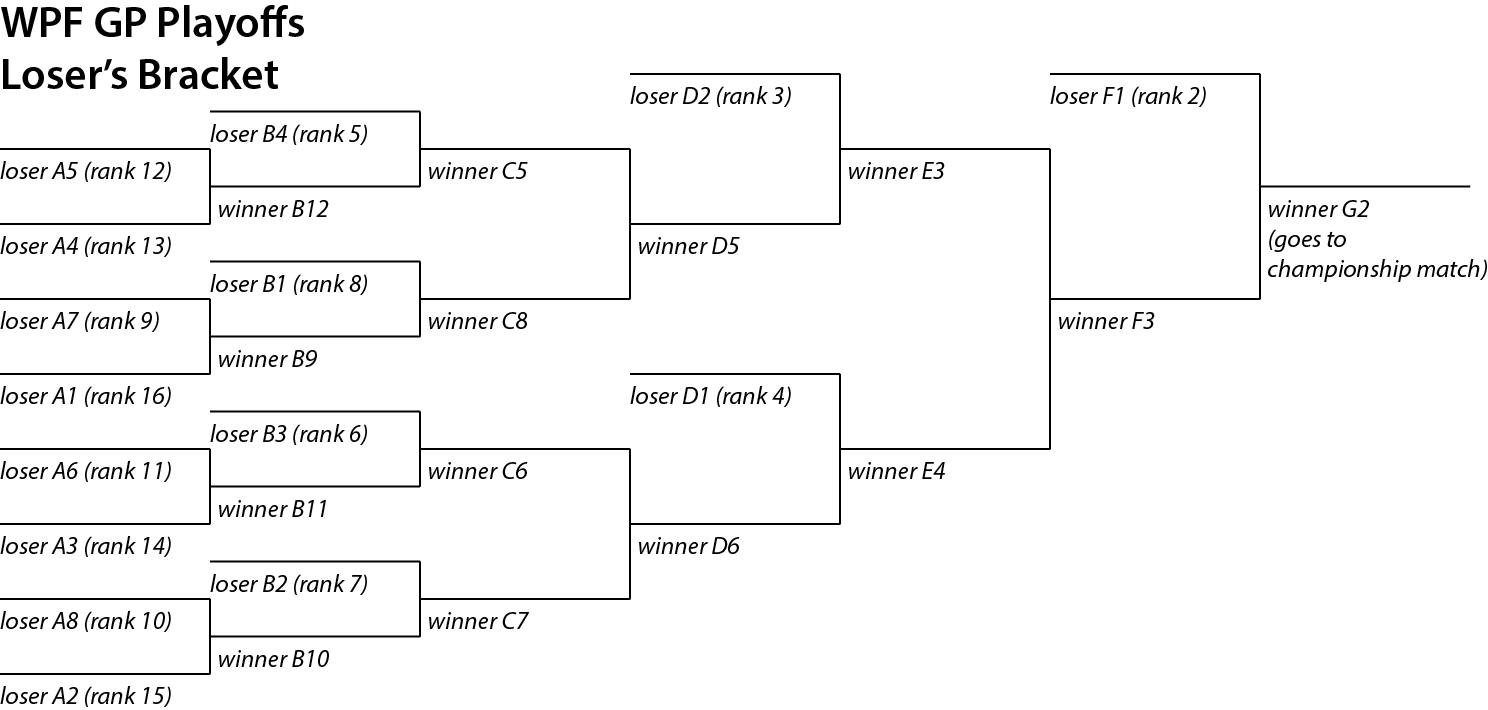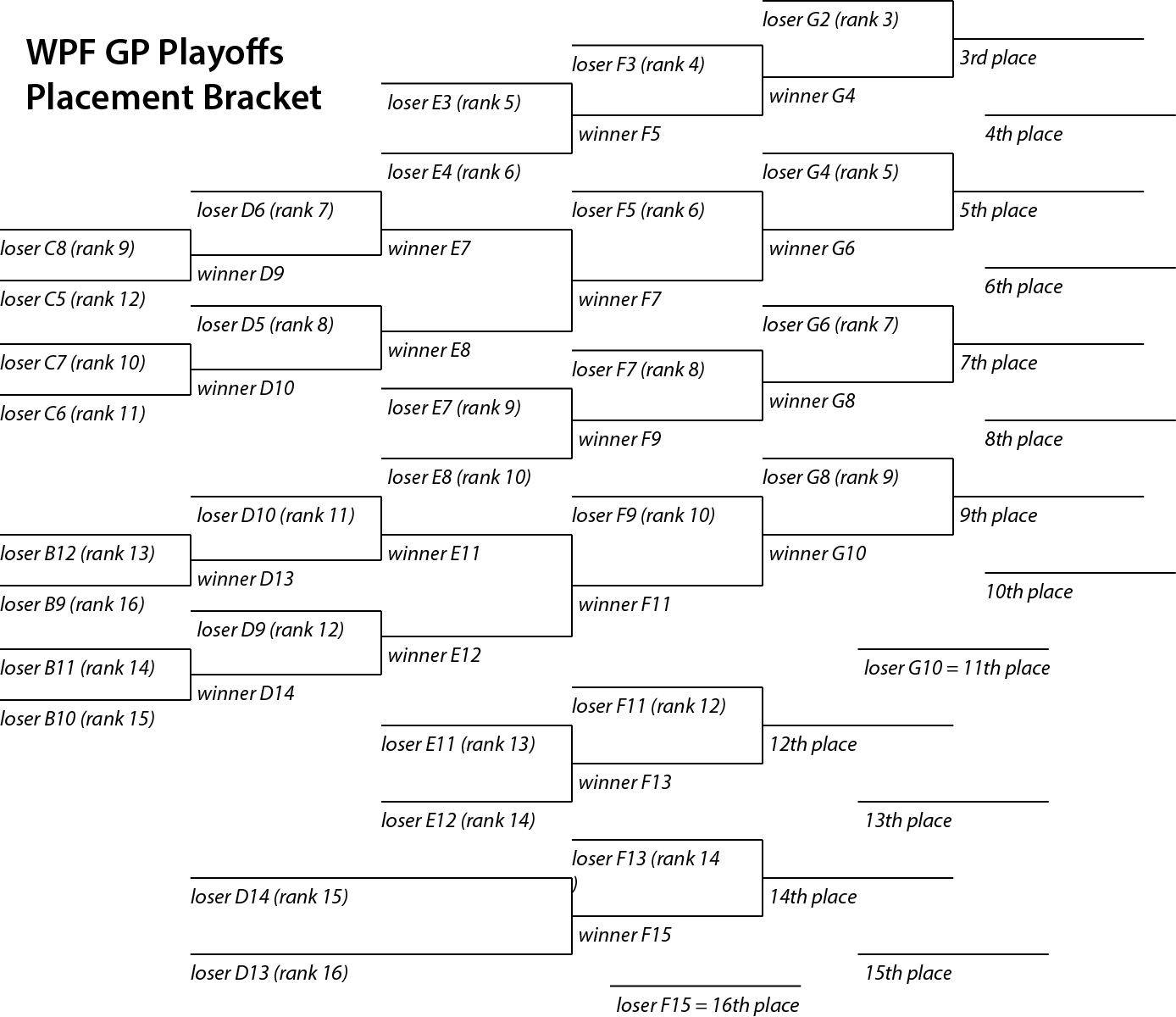You are here
GP Playoff Rules
WPF GP Playoff Rules
Introduction
The WPF GP Playoffs will be in a format called Swiss Elimination. It is a head-to-head format, where each competitor is matched against one or zero other competitors each round. A subset of the matches are identical to a standard double-elimination format, so once a player loses two matches, they are ineligible to win the championship. Extra matches are used to determine a full ranking of all players, so even eliminated players must continue to compete to attain as high a ranking as possible.
16 players will qualify for the playoffs, seeded by their position in the regular competition (these rules are unchanged from that on the website). However, the advantage in seed will no longer be time-based, but rather in the matchups and (for one player each round) puzzle selection.
The Rules for here are intended to be complete; however, situational differences (such as the venue unable to support A/V requirements) may result in on-the-fly changes to these rules.
Rule Changes 2024
- September 4th: Revised schedule added for 2024.
- September 7th: Details about the stages have been updated for 2024.
- September 7th: Revisions to the details about the live stage have been updated for 2024. The main changes are that there are now 6 heats each with a separate puzzle and that the full 10 minutes are in use.
- September 12th: Draft version uploaded to live website
- September 14th: Link to side tournament added
Schedule for 2024
Because of the tightness of this year's schedule, the puzzle selection for both Sudoku and Puzzle GP is predetermined randomly.
- September 7th: Email sent to top 30 finishers in Sudoku GP and Puzzle GP (see Eligibility, below).
- September 11th: Deadline for top finishers to respond to email.
- September 12th-18th: Online stage
- October 15th-21th: Live stage
Eligibility
Each player’s eligibility score is calculated. The score of their six best rounds in the corresponding (Sudoku or Puzzle) GP competition is added together to get the eligibility score.
To be eligible, a player must both:
- Have one of the top 30 eligibility scores. These players will be sent an email from the WPF.
- Express an intention to be present at the live finals at the World Sudoku + Puzzle Championship in response to that email.
The 16 eligible players with the highest eligibility scores will be invited to the playoffs, and get their initial seed based on their eligibility score.
In the rare case that there are fewer than 16 eligible players, or a finalist ends up not being present at the WSPC due to extenuating circumstances, they will be replaced with a virtual “bye” player. A “bye” player is seeded worst and loses all head-to-head competitions.
Stages
The playoffs will have two stages; an online stage followed by a livestage. Aspects that are the same between the stages are:
- Each player will have an opponent in each match. (See details later in this document.)
- The match will be on a single puzzle.
- The puzzle will be taken from a puzzle pool of potential puzzles. One player will have some selection control over which puzzles are used.
- Each player will get an official time for each puzzle (representing how much time it took them to solve the puzzle).
- The player with the faster (smaller) official time will win the match.
The differences between the stages are as follows:
Online Stage
- For 2024, the online stage will happen from September 12th to September 18th.
- 45 matches total.
- Players compete separately, on their own, in a setup similar to that of the regular GP rounds
- There will be 8 puzzles, each one presented as a separate “round” of one puzzle each. Each round has a maximum time of 20 minutes.
- Players must submit answer strings as specified in the puzzle. They may submit multiple times; however, only the last-submitted set of answer strings will be scored.
- A player’s official time for each puzzle is 22 minutes if their submission is incorrect. Otherwise, it is the time between the start of the password request and the time of submission.
- At most 7 puzzles will be used in the official online stage.
- Players will not know which 7 puzzles will be used, their opponent for each puzzle, or their official times. Players might have a general idea of their own performance, but the WPF requests that the players keep their estimated solve times a secret and not share them before the live stage.
Live Stage
- For 2024, the live stage will happen at the World Sudoku and Puzzle Championship.
- 9 matches total.
- At the beginning of the live stage, the official results of the online stage will be presented to the players and the audience. This will include:
- The official final rankings of 11th place through 16th place.
- The two players who will be competing in one match, for 9th and 10th place.
- The two players who will be competing in one match, for 7th and 8th place.
- The rank 6 player, who will be competing in one match, for 5th or 6th place.
- The rank 5 player, who will be competing in two matches, for 3rd to 6th place.
- The rank 3 and rank 4 players, who will be competing in three matches for 1st to 6th place.
- The rank 1 and rank 2 players, who will be competing in two or three matches for 1st to 4th place.
- The players must solve the puzzle live and on camera. Details regarding errors and timing are identical to past GP Playoffs and are detailed later in this document.
- The puzzles will be from a pool of 6 puzzles. The order of the puzzles will be determined by the competitors during the live event.
Side Tournament
- For 2024, a side tournament will be run at the same time as the GP finals. It will accommodate between 9 and 64 players, and be structured like a single-elimination tournament. The 10 players in the live stage are not eligible to participate in the side tournament, but 11th place through 16th place are. The detailed rules for the tournament are available here.
Puzzles and Rounds
There will be 8 rounds in the playoffs, labeled with a letter from A through H. Each round will have a number of head-to-head matches, each one with a match code descriptive of its round or placement. Each match will have two players, who will compete against each other on a single puzzle to see who can solve it in the fastest amount of time.
Each GP round host country has contributed one or more puzzles for use in the finals. The GP Director will choose one puzzle from each of seven countries to be used as the puzzle pool for the online stage. The GP Director will also choose six puzzles from different countries to be placed in the puzzle pool for the live stage. One puzzle will be chosen at random from the pool to be used each round for the online stage, and puzzles will be chosen from the pool to be used for the live stage.
Seed and Rank
Each player has a seed (numbered ordinally from 1st to 16th) and a rank (also numbered ordinally from 1st to 16th). At the start of the tournament, these two numbers are identical for each player; e.g., the player with 6th seed also has 6th rank.
The initial seed/rank is determined by the player’s performance in the regular competition. A seed/rank with a smaller number is considered better (for example, 4th rank is better than 5th rank), and a seed/rank with a larger number is considered worse.
Each round matches some players based on their rank, who then compete against each other on a single puzzle to see who can solve it in the fastest amount of time. If the player with the better rank wins, the two players keep their ranks for the next round. If the player with the worse rank wins, then the two players swap their ranks for the next round. In the rare case of a tie, the player with the better seed wins.
After eight rounds of competition (seven for ranks 11th through 16th), the rank of the players determine the finishing order.
Brackets
Each match is in one of three brackets based on its players’ performance:
- The Winner’s Bracket is for matches involving players who have not lost any matches.
- The Loser’s Bracket is for matches involving players who have lost exactly one match.
- The Placement Bracket is for matches involving players who have lost two or more matches.
The list of matches and their relevant data are as follows:
|
Round letter |
Match code |
Player Ranks |
Bracket |
|
A |
A1 |
1,16 |
Winner's |
|
A2 |
2,15 |
Winner's |
|
|
A3 |
3,14 |
Winner’s |
|
|
A4 |
4,13 |
Winner’s |
|
|
A5 |
5,12 |
Winner’s |
|
|
A6 |
6,11 |
Winner’s |
|
|
A7 |
7,9 |
Winner’s |
|
|
A8 |
8,10 |
Winner’s |
|
|
B |
B1 |
1,8 |
Winner's |
|
B2 |
2,7 |
Winner's |
|
|
B3 |
3,6 |
Winner's |
|
|
B4 |
4,5 |
Winner's |
|
|
B9 |
9,16 |
Loser’s |
|
|
B10 |
10,15 |
Loser’s |
|
|
B11 |
11,14 |
Loser’s |
|
|
B12 |
12,13 |
Loser’s |
|
|
C |
C5 |
5,12 |
Loser's |
|
C6 |
6,11 |
Loser's |
|
|
C7 |
7,10 |
Loser’s |
|
|
C8 |
8,9 |
Loser’s |
|
Round letter |
Match code |
Player Ranks |
Bracket |
|
D |
D1 |
1,4 |
Winner’s |
|
D2 |
2,3 |
Winner’s |
|
|
D5 |
5,8 |
Loser’s |
|
|
D6 |
6,7 |
Loser’s |
|
|
D9 |
9,12 |
Placement |
|
|
D10 |
10,11 |
Placement |
|
|
D13 |
13,16 |
Placement |
|
|
D14 |
14,15 |
Placement |
|
|
E |
E3 |
3,5 |
Loser’s |
|
E4 |
4,6 |
Loser’s |
|
|
E7 |
7,9 |
Placement |
|
|
E8 |
8,10 |
Placement |
|
|
E11 |
11,13 |
Placement |
|
|
E12 |
12,14 |
Placement |
|
|
F |
F5 |
5,6 |
Placement |
|
F7 |
7,8 |
Placement |
|
|
F9 |
9,10 |
Placement |
|
|
F11 |
11,12 |
Placement |
|
|
F13 |
13,14 |
Placement |
|
|
F15 |
15,16 |
Placement |
|
|
G |
G6 |
6,7 |
Placement |
|
G8 |
8,9 |
Placement |
|
|
G10 |
10,11 |
Placement |
|
|
G12 |
12,13 |
Placement |
|
|
G14 |
14,15 |
Placement |
Heats for the Live Stage
For efficiency reasons, up to two matches will be conducted at the same time, and be shown to the audience, with commentary. Each pair of such matches is called a heat. There will be 5 heats. A full list of matches for the live stage is listed below.
|
Round letter |
Heat |
Match code |
Player Ranks |
Bracket |
|
F |
1 |
F1 |
1,2 |
Winner's |
|
F3 |
3,4 |
Loser’s |
||
|
G |
2 |
G2 |
2,3 |
Loser’s |
|
G4 |
4,5 |
Placement |
||
|
H |
3 |
H7 |
7,8 |
Placement |
|
H9 |
9,10 |
Placement |
||
|
4 |
H5 |
5,6 |
Placement |
|
|
5 |
H3 |
3,4 |
Placement |
|
|
6 |
FINAL |
1,2 |
Championship |
A strategy path diagram, showing the matches is below.
Traditional elimination diagrams for the brackets are below.
Puzzle Selection
The Sudoku GP and Puzzle GP will use the same method of assigning puzzles to rounds; these rules are subject to change depending on decisions of the respective GP directors.
For the online stage, the players are not involved in selecting puzzles. The order of puzzles will be a random ordering of the seven puzzles in the pool.
For the live stage, the player with rank 1 (not seed 1) will choose that round’s puzzle from the pool of puzzles at the start of each round. Once a puzzle is selected, it is removed from the pool. The number of puzzles selected depends on
- At the start of Round F, the player with rank 1 will choose the puzzle for that round (Heat 1).
- At the start of Round G, the player with rank 1 will choose the puzzle for that round (Heat 2). (Note that they do not compete on solving that puzzle, which can affect their strategy.)
- At the start of Round H, the player with rank 1 will choose the puzzle for Heat 6.
- Then the player with rank 3 will choose the puzzle for Heat 5.
- Then the player with rank 5 will choose the puzzle for Heat 4.
- The remaining puzzle will be the puzzle for Heat 3.
New Puzzle Sheets (Live Stage Only)
A competitor can request a new puzzle sheet in case they feel they have made an unrecoverable error to the sheet. They must relinquish their old sheet first, and then a new sheet will be supplied. (So, they would not be allowed to have both sheets at the same time.) There will be no compensation for the transition period when they have no sheets. A competitor can request a new sheet at most once per match, to prevent abuse of this rule.
It is expected that this will be a rare occurrence, and only a limited number of extra sheets will be available to all competitors over the round. If there are not enough extra sheets to supply all competitors in the current heat, then this will be announced before the start of the current heat and no competitors will be allowed to request new sheets.
Grading (Live Stage Only)
In a head-to-head match, the competitor with the worse seed (not rank) wins the match if they solve the puzzle in less than 10 minutes and they solve it faster than the other competitor (with the better seed). Otherwise, the competitor with the better seed wins the match.
The punishment for an incorrect answer is a one-minute penalty.
Timers will be used to determine each player’s solving time as follows:
There will be a large shared timer visible to all competitors, graders, and judges, and each competitor will have an individual precision timer. A grader will be next to each competitor, and one or more judges will be around to record times and enforce these rules.
Before the match starts, the competitor must hold their hands on their precision timer; the puzzle sheet will be placed between the timer and the competitor, face-down.
At the judge’s signal, the shared timer starts and competitors let go of the precision timer (which starts it) and start solving.
When a competitor believes their answer is correct, they must slide their puzzle sheet to the grader and touch the precision timer with both hands to stop the timer. The grader notes the time on the shared timer, and has up to one minute to grade the puzzle sheet. A judge will come by, record the competitor’s official time from the precision timer, and reset the precision timer. The next step depends on whether the answer is correct and the state of the other grader.
- If the answer is correct and the other grader is currently grading, the grader finishes grading silently and waits until the full minute is up or until the other grader’s full minute is up, whichever is earlier. At that point, the grader announces the presence of a correct answer.
- If the answer is correct and the other grader is not currently grading, the grader announces the correct answer as soon as this is determined. The other competitor may continue solving.
- If the answer is incorrect, the grader waits until the end of the full minute, and then if the competition is not over, then the grader instructs the competitor to put their hands on the timer for one second to prepare it. The puzzle sheet is returned to the competitor face-down, with no information other than the answer being wrong. The competitor then releases their hands, flips over their incorrect sheet, and continues.
The match stops when the shared time reaches 10 minutes. (Unlike previous years, we use the full 10 minutes to accommodate the side tournament.)
When the match stops, there will either be one correct answer, in which case that competitor wins; two correct answers, in which case the competitor who submitted with less official time spent wins; or no correct answers, in which case the better-seeded competitor wins.
In the very rare case where there is a tie and the judges cannot determine for sure which competitor has the faster solve time, then the better-seeded player will be the winner (same as if there were no correct answers).
If there is a malfunction in the timers or an error in procedures, the judges will do their best job to adhere to the spirit of these rules. Judges’ decisions are final.






